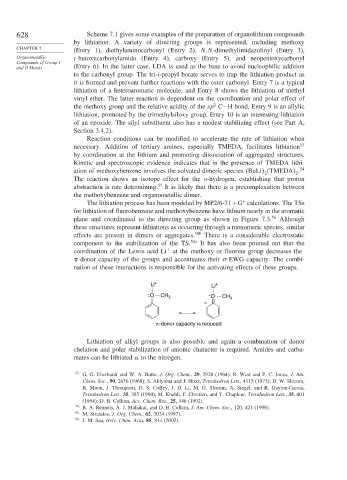Page 653 - Advanced Organic Chemistry Part B - Reactions & Synthesis
P. 653
628 Scheme 7.1 gives some examples of the preparation of organolithium compounds
by lithiation. A variety of directing groups is represented, including methoxy
CHAPTER 7 (Entry 1), diethylaminocarbonyl (Entry 2), N,N-dimethylimidazolinyl (Entry 3),
Organometallic t-butoxycarbonylamido (Entry 4), carboxy (Entry 5), and neopentoxycarbonyl
Compounds of Group I
and II Metals (Entry 6). In the latter case, LDA is used as the base to avoid nucleophilic addition
to the carbonyl group. The tri-i-propyl borate serves to trap the lithiation product as
it is formed and prevent further reactions with the ester carbonyl. Entry 7 is a typical
lithiation of a heteroaromatic molecule, and Entry 8 shows the lithiation of methyl
vinyl ether. The latter reaction is dependent on the coordination and polar effect of
2
the methoxy group and the relative acidity of the sp C−H bond. Entry 9 is an allylic
lithiation, promoted by the trimethylsiloxy group. Entry 10 is an interesting lithiation
of an epoxide. The silyl substituent also has a modest stabilizing effect (see Part A,
Section 3.4.2).
Reaction conditions can be modified to accelerate the rate of lithiation when
necessary. Addition of tertiary amines, especially TMEDA, facilitates lithiation 53
by coordination at the lithium and promoting dissociation of aggregated structures.
Kinetic and spectroscopic evidence indicates that in the presence of TMEDA lithi-
ation of methoxybenzene involves the solvated dimeric species BuLi TMEDA . 54
2 2
The reaction shows an isotope effect for the o-hydrogen, establishing that proton
abstraction is rate determining. 55 It is likely that there is a precomplexation between
the methoxybenzene and organometallic dimer.
∗
The lithiation process has been modeled by MP2/6-31+G calculations. The TSs
for lithiation of fluorobenzene and methoxybenzene have lithium nearly in the aromatic
plane and coordinated to the directing group as shown in Figure 7.3. 56 Although
these structures represent lithiations as occurring through a monomeric species, similar
effects are present in dimers or aggregates. 50b There is a considerable electrostatic
component to the stabilization of the TS. 50a It has also been pointed out that the
+
coordination of the Lewis acid Li at the methoxy or fluorine group decreases the
-donor capacity of the groups and accentuates their -EWG capacity. The combi-
nation of these interactions is responsible for the activating effects of these groups.
Li + Li +
: O CH 3 + O CH 3
–
π-donor capacity is reduced
Lithiation of alkyl groups is also possible and again a combination of donor
chelation and polar stabilization of anionic character is required. Amides and carba-
mates can be lithiated
to the nitrogen.
53
G. G. Eberhardt and W. A. Butte, J. Org. Chem., 29, 2928 (1964); R. West and P. C. Jones, J. Am.
Chem. Soc., 90, 2656 (1968); S. Akiyama and J. Hooz, Tetrahedron Lett., 4115 (1973); D. W. Slocum,
R. Moon, J. Thompson, D. S. Coffey, J. D. Li, M. G. Slocum, A. Siegel, and R. Gayton-Garcia,
Tetrahedron Lett., 35, 385 (1994); M. Khaldi, F. Chretien, and Y. Chapleur, Tetrahedron Lett., 35, 401
(1994); D. B. Collum, Acc. Chem. Res., 25, 448 (1992).
54 R. A. Rennels, A. J. Maliakal, and D. B. Collum, J. Am. Chem. Soc., 120, 421 (1998).
55 M. Stratakis, J. Org. Chem., 62, 3024 (1997).
56
J. M. Saa, Helv. Chim. Acta, 85, 814 (2002).

